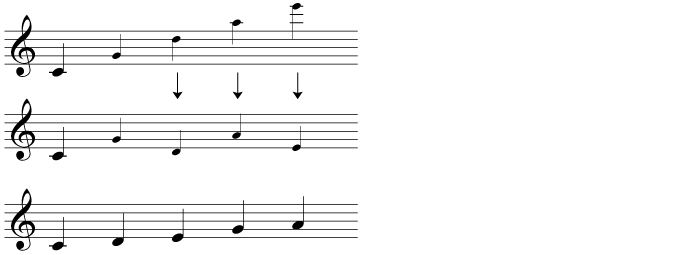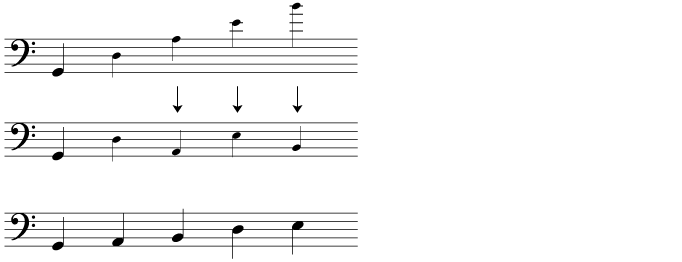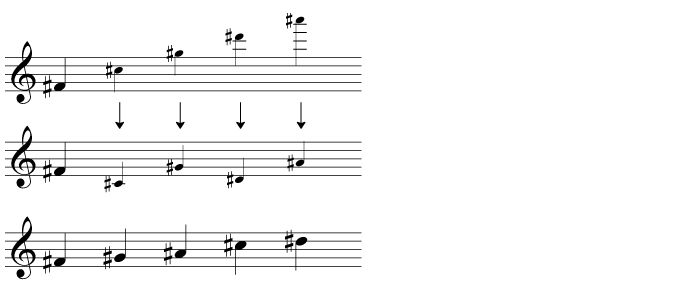The pentatonic scale
In this guide...
Key terms:
Subscription required!
To view the complete study guide, you will need a valid subscription. Why not subscribe now?
Already have a subscription? Make sure you login first!
Introduction
We have previously covered two types of scale - diatonic and chromatic - and now we will introduce a third type, the pentatonic scale.
Diatonic scales
The diatonic scales are simply the familiar major and minor scales, which are made up of distinctive patterns of tones and semitones.
For example, here is a diatonic scale - in this case, the scale of B flat major, showing the tone and semitone pattern:
 The scale of B flat major: a diatonic scale
The scale of B flat major: a diatonic scaleDiatonic scales can start on any note, so long as the correct pattern for the major scale or one of the minor scales is followed.
Another important feature of diatonic scales is that each note has a specific name, for example, the tonic or 1st degree. Some notes are more important than others, specifically, the tonic and dominant.
Chromatic scales
The chromatic scale, likewise, can start on any note. However unlike diatonic scales, each note is equal and no note is important than any other. As a result of this, there are no special names for the notes and the scale is the same regardless of which note you start on.
Here is a chromatic scale starting on C:
 A chromatic scale starting on C
A chromatic scale starting on CWe covered chromatic scales in some detail in The chromatic scale.
Pentatonic scales
This brings us to a new type of scale: the pentatonic scale.
As you can probably guess from the name, just as a pentagon has five sides, the pentatonic scale has five notes (unlike diatonic scales which have 7, and the chromatic which has 12).
There are several ways to formulate a pentatonic scale, but one with which you are no doubt already familiar involves simply playing the black keys on a piano:
 A pentatonic scale starting on F sharp, using the black keys of a piano
A pentatonic scale starting on F sharp, using the black keys of a pianoA more formal definition
However this description of a pentatonic scale as "the black keys on a piano" is not very helpful, particularly if we don't have a piano handy.
A more accurate description of the construction of the pentatonic scale is:
- Choose your starting note (for example, C)
- Add four notes, each at a perfect fifth above the last (for example, G, D, A, E)
- Transpose the last three of these notes to the same octave as the first two notes
- Arrange them in ascending order, starting on C to create a pentatonic scale (in this example, a pentatonic scale on C)
Graphically, this process looks like this:
 Construction of a pentatonic scale starting on C
Construction of a pentatonic scale starting on CStarting on different notes
This process for constructing a pentatonic scale works with any start note. Here is the pentatonic scale on G, this time using the bass clef:
 Construction of a pentatonic scale starting on G, bass clef
Construction of a pentatonic scale starting on G, bass clefCheck this G pentatonic scale against the C pentatonic scale. Each note in the G pentatonic scale is exactly a perfect fifth above the corresponding note in the C pentatonic scale, proving that they are the same type of scale and are transpositions of each other.
Constructing the black key version
We can, of course use this same process to construct our "black key" version of the pentatonic scale. All we have to do is to start on F sharp, as shown here:
 Construction of a "black key" pentatonic scale
Construction of a "black key" pentatonic scaleLook again at the second step of the "black key" construction ... does that pattern of sharps look familiar?
Hint: Look at the key signature for B major!
Uses of the pentatonic scale
The pentatonic scale is often found in Chinese music. It would however be more accurate to say that traditional Chinese uses the pentatonic scale as described above, but the Chinese system also uses other varieties of pentatonic scale (also with 5 notes each) that we have not discussed here.
As a result, it is very common in Western music to find pentatonic scales used when the composer wants to imply some kind of oriental flavour. This use is often thought of today as being somewhat crass and unsubtle.
Here, however, is a section of a piece by Debussy that does not attempt to "sound oriental"; instead, Debussy's intention is to get the performer to think generally of both "veils" and "sails", as the title Voiles has a double meaning in French.
 from Debussy, Voiles
from Debussy, VoilesIf you look carefully - or if you try playing this music - you will see that it uses the "black keys" only; this is the enharmonic equivalent of the "black key" scale that we have seen starting, on F sharp. In this case, it starts on G flat (the enharmonic equivalent to F sharp).
The Debussy example above has been reduced from the original, for clarity. If you are able to look at this section in the original, you will see how Debussy has been able to write some complex and very free-flowing music using just the notes of the pentatonic scale on G flat.
Other scales
Now that you know about the diatonic, chromatic, and pentatonic scales, you might think that's the end of the story.
However, there are many more types of scales, each of which has its own distinctive character. Here are a few for you to find out about:
- Blues scale
- Whole-note scale
- Modes (dorian, aeolian, lydian, etc.)
- Octatonic scale
Read more...
With a subscription to Clements Theory you'll be able to read this and dozens of other study guides, along with thousands of practice questions and more! Why not subscribe now?